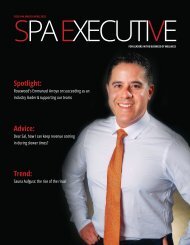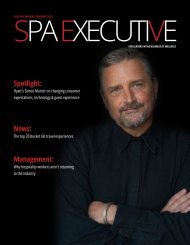Spa Executive_MARCH-2021-V3
Create successful ePaper yourself
Turn your PDF publications into a flip-book with our unique Google optimized e-Paper software.
MANAGEMENT<br />
Employee stress is a factor in<br />
hospitality and your team’s<br />
wellbeing is as important as that<br />
of your guests. Here’s how to<br />
make a difference.<br />
We spoke to Ryan Wolf, Gallup’s Physical Wellbeing Lead, about<br />
how hospitality leaders can apply those five principles to alleviate<br />
employee stress, improve wellbeing, and create healthy, happy<br />
workplaces. Here’s how he answered our questions.<br />
HOW MANAGERS CAN<br />
REDUCE EMPLOYEE STRESS<br />
IN SPA & HOSPITALITY<br />
Working in spa and hospitality is stressful. Work is<br />
demanding and the pressure to offer the ultimate<br />
guest experience while keeping up with safety<br />
protocols can be a lot to handle. Burnout, as we all<br />
know, is not uncommon.<br />
Moreover, a recent report found that travel and<br />
hospitality employees are the least likely out of<br />
all industries surveyed to feel valued at work. And<br />
separate research found that feeling undervalued<br />
at work was correlated with the highest levels of<br />
workplace stress. In other words: hospitality is<br />
already a stressful sector, and the common feeling<br />
of being undervalued adds stress to that stress.<br />
The five elements we need to thrive<br />
This costs hospitality companies. Stress has been<br />
called the “health epidemic of the 21st century” by<br />
the World Health Organization and the “business<br />
world’s silent killer” by Forbes. It’s estimated to cost<br />
American businesses alone up to $300 billion a year.<br />
The hospitality world is very focused on creating a<br />
stress-free guest experience and on guest wellbeing.<br />
Managers should also be sure to spend time and<br />
energy on the wellness and wellbeing of their<br />
employees.<br />
Employee wellbeing matters for your<br />
wellness business<br />
Advisory company Gallup studied wellbeing in more<br />
than 98% of the world’s population and identified<br />
five common elements that people need to thrive in<br />
their professional and personal lives. Gallup found<br />
that how employees rate these five elements affects<br />
business outcomes:<br />
Career: You like what you do every day.<br />
Social: You have meaningful friendships in your life.<br />
Financial: You manage your money well.<br />
Community: You like where you live.<br />
Physical: You have energy to get things done.<br />
What’s the manager’s role in<br />
employee wellbeing?<br />
Workplace wellness started as a way<br />
for employers to shed some of their<br />
increasing healthcare costs. So, a lot of<br />
the initiatives were to help employees<br />
lose weight or get more exercise.<br />
But workplace wellness has evolved<br />
tremendously over the past 30-40 years,<br />
and now integrates all determinants<br />
of health and happiness. It’s not just<br />
going to the gym and eating broccoli, it’s<br />
thinking about how your relationships<br />
and your career support your health.<br />
Leadership needs to have a strategy for<br />
wellbeing and managers can make or<br />
break that strategy. It can be challenging<br />
because they don’t necessarily want to<br />
be a wellbeing expert or a life coach for<br />
their employees. But they don’t need<br />
to be the experts. They just need to<br />
be conduits and good dot connectors<br />
to help identify available resources<br />
based upon specific needs. Sometimes<br />
these resources are available through<br />
programs already available in the<br />
organization, and sometimes they are<br />
outside the organizations. Everyone<br />
has a special wellbeing need. Our<br />
needs are as individualized as we are<br />
individual human beings. Recognizing an<br />
individual’s needs and supporting them<br />
in finding the resources they need is the<br />
manager’s role.<br />
How do the five elements Gallup<br />
identified factor in?<br />
Physical wellbeing is often the first<br />
pathway people focus on, but now we<br />
think of physical wellbeing as efficiently<br />
managing your energy so you can<br />
take care of the important things in<br />
your life: having creative and mental<br />
energy for work and emotional energy<br />
for relationships. The work we do,<br />
the passion that we pour into it, the<br />
purpose and meaning that we get out<br />
of our work, our relationships and<br />
friendships, are all very important<br />
for longevity, physical wellbeing, and<br />
happiness.<br />
Can you talk about ways to<br />
avoid burning out employees?<br />
Gallup also identified five<br />
major reasons that people burn<br />
out: being treated unfairly, an<br />
unmanageable workload, a lack of<br />
expectations within their role, lack of<br />
communication, and unreasonable<br />
time pressure. It’s the responsibility of<br />
leaders to address these issues.<br />
We’ve also found four elements<br />
that employees need from leaders.<br />
These are hope, stability, trust, and<br />
compassion. Leaders should be<br />
intentional about these things. Caring<br />
about people is very simple. It comes<br />
down to caring about people more<br />
than just their productive units and<br />
knowing that engagement at work<br />
is highly linked and correlated to<br />
wellbeing.<br />
How can managers lift some of<br />
the employee stress their teams<br />
are experiencing right now?<br />
Being communicative, helping<br />
people understand what’s expected<br />
of them, and being clear about the<br />
organization’s financial situation and<br />
what the plans are going forward are<br />
very important at this time.<br />
Another thing is playing to the<br />
strengths of each individual employee<br />
and understanding what makes them<br />
tick and the kind of work in which they<br />
thrive. Identify that setting and help<br />
them develop by doing more of that.<br />
CliftonStrengths is a tool that we<br />
use to help individuals identify their<br />
strengths. There are four domains<br />
of strengths: relationship building,<br />
strategic thinking, influencing, and<br />
executing. Someone who is a really<br />
high executer likes to get things<br />
done. They might like checklists<br />
and just doing hard work. It wouldn’t<br />
necessarily be wise to have that<br />
person at the front desk of the hotel<br />
or spa, checking people in and making<br />
small talk. We’d want to put someone<br />
who thrives in relationship building<br />
and influencing in front of people. So,<br />
they can be more of who they are and<br />
help the clientele feel comfortable.<br />
What makes a great employee<br />
wellness experience?<br />
We need to think about who these<br />
individuals are and help them carve a<br />
path to explore and experiment with<br />
ways to live their best life. Rather<br />
than providing programs that try to fit<br />
everyone in a box, we should be giving<br />
people the autonomy to experiment<br />
with what might work best for them.<br />
<strong>Spa</strong> <strong>Executive</strong> <strong>MARCH</strong> <strong>2021</strong> ISSUE - 10 - - 11 - <strong>Spa</strong> <strong>Executive</strong> <strong>MARCH</strong> <strong>2021</strong> ISSUE


















